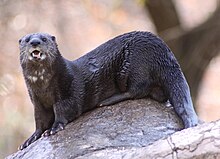Hydrictis
| Spotted-necked otter | |
|---|---|
 |
|
| Scientific classification | |
| Kingdom: | Animalia |
| Phylum: | Chordata |
| Class: | Mammalia |
| Order: | Carnivora |
| Suborder: | Caniformia |
| Family: | Mustelidae |
| Genus: |
Hydrictis Pocock, 1921 |
| Species: | H. maculicollis |
| Binomial name | |
|
Hydrictis maculicollis (Lichtenstein, 1835) |
|
 |
|
| Distribution of spotted-necked otter | |
| Synonyms | |
|
Lutra maculicollis |
|
Lutra maculicollis
The spotted-necked otter (Hydrictis maculicollis), or speckle-throated otter, is an otter native to sub-Saharan Africa.
The spotted-necked otter is a smallish species, with males measuring 71 to 76 cm (28 to 30 in) from nose to rump, and weighing 5.7 to 6.5 kg (13 to 14 lb), while females are 57 to 61 cm (22 to 24 in) and 3.0 to 4.7 kg (6.6 to 10.4 lb). The tail is long and muscular, measuring 39 to 44 cm (15 to 17 in) in both sexes. Like many other otters, it is sleek and has webbed paws for swimming. Females have two pairs of teats, and while males have a large scrotum, the penis is hidden beneath the skin, to reduce drag while swimming.
Although considerable variation exists among individuals, their fur is usually reddish to chocolate brown and marked with creamy or white blotches over the chest and throat. The head is broad with a short muzzle, small rounded ears, and a hairless nose pad. The teeth are adapted for consuming fish, with large sharp upper canine teeth, curved lower canines, and sharp carnassial teeth. The jaws are similarly adapted, with the mandibular fossa fitting so snugly into the condyle on the lower jaw that the latter cannot move sideways, making it easier to capture and hold fish.
Although up to five subspecies have previously been identified, these most likely represent a natural variation in appearance between individuals, and no subspecies are currently recognised.
Spotted-necked otters are found in lakes and larger rivers throughout much of Africa south of 10°N. They are common in Lake Victoria and across Zambia, but for some unexplained reason often are absent from what appear to be suitable habitats, such as the lakes and rivers of East Africa and the Zambezi below Victoria Falls. No evidence of spotted-necked otters venturing into salt water has been found.
Spotted-necked otters feed primarily on fish, typically less than 20 cm (7.9 in) in length, but also eat frogs and small crustaceans, especially when fish are in short supply. They are diurnal, and appear to hunt entirely by sight using short dives of less than 20 seconds each in clear water with good visibility. Larger prey items are carried ashore, while smaller items are eaten while treading water. Known predators on the otters include crocodiles and African fish eagles.
...
Wikipedia

